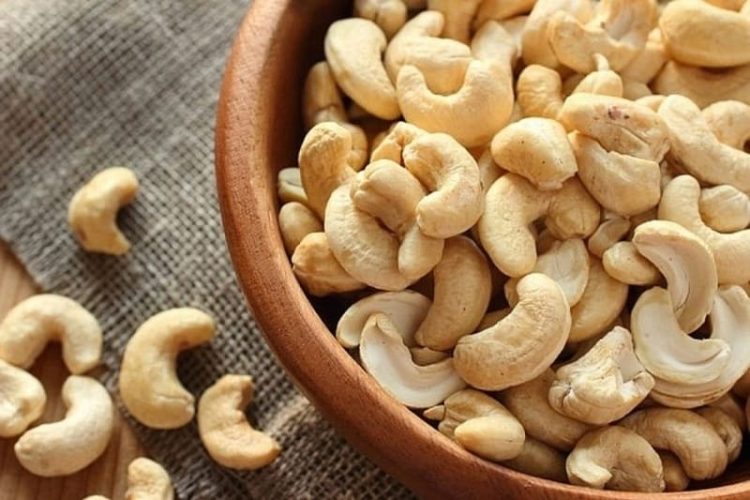Among all cashew-exporting countries, Vietnam remains the dominant supplier by volume. In 2023, the country accounted for over 80 percent of global processed cashew exports, with over 127,000 metric tons shipped to the U.S. alone, valued at 746 million USD. In retail, cashews rank among the most consumed snack nuts in the U.S. market. That confirms consistent domestic demand and strong chances for new or scaling importers.
Despite the clear market potential, cashew shipments from the country to the US are often held up due to missing FDA prior notice, wrong HS codes, or poor supplier documentation. So, how to import cashews from Vietnam efficiently? In this article, we will give you a comprehensive guide, covering the import process step by step, what documentation is required, and how to meet U.S. regulatory requirements.
Why Import Cashews From Vietnam to the US?
Cashew has been one of the leading Vietnam export products to the world in general and to the United States in particular, followed by coffee and black pepper. The US began importing Vietnamese cashew in large volumes around 2002, with steady growth each year.
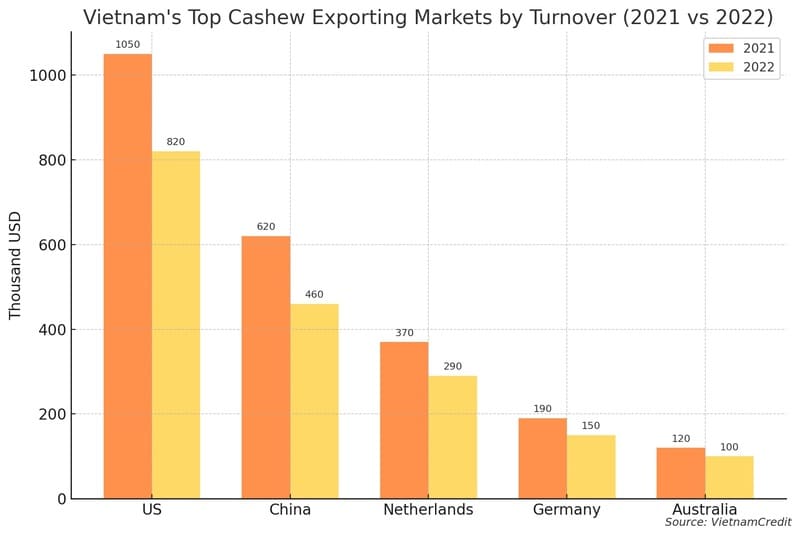
In 2024, Vietnamese cashews exported to the US reached 192,200 metric tons, worth over 1.15 billion USD. This marked an increase from 2023, where US imports from Vietnam were 127,570 tons, valued at 746 million USD. Imports are projected to remain strong for the US market in the following years.
Benefits of importing Vietnamese cashew:
- Guaranteed large-volume availability all year (Vietnam controls over 80% of global processed cashew exports).
- Consistent access to high-demand U.S. retail grades like W320, W240, and W180 (over 63% of Vietnam’s exports).
- Shorter lead times due to year-round operations from 500+ cashew processors.
- Faster customs clearance since most exporters are already FDA, APHIS, and USDA compliant.
- One supplier can offer multiple SKUs including roasted, salted, and organic cashews.
Common Types of Vietnamese Cashew Exports
So, what are the key product types for exporting? In the United States, the cashew market is primarily dominated by the following categories:
1. Whole Shelled Kernels
Whole shelled kernels are intact cashew halves, typically in export grades like W320, W240, and W180. These are the most common export type from Vietnam. In 2024, they accounted for the majority of shipments to the U.S., estimated to be over 65 percent of total cashew export volume to the states.
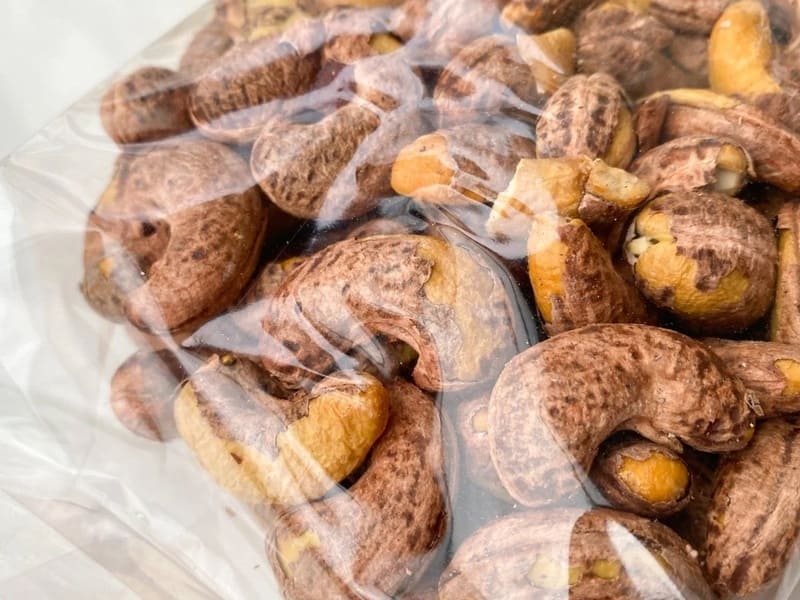
2. Broken Cashew Kernels
Broken kernels include pieces such as LWP (Large White Pieces), SWP (Small White Pieces), and BB (Baby Bits). You often find this type in confectionery, bakery, and snack manufacturing. While exact U.S. import volume is not published, broken cashew exports globally make up around 15 to 20 percent of Vietnam’s total kernel exports.
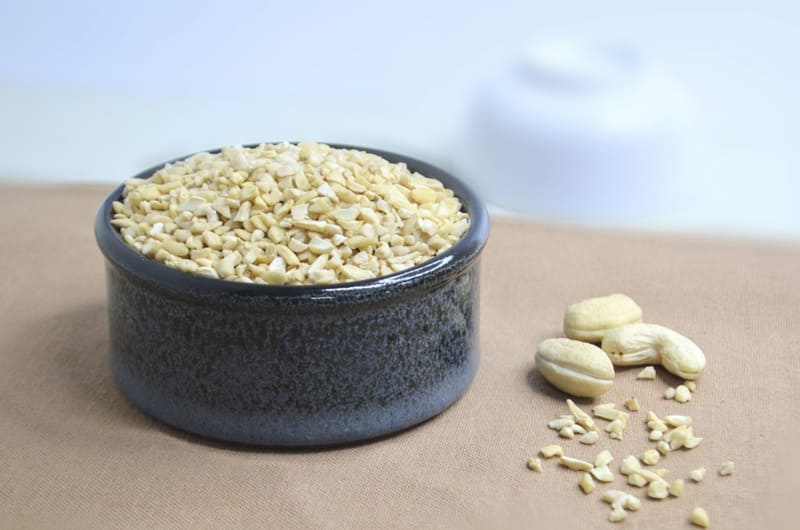
3. Roasted and Seasoned Cashews
Roasted and seasoned cashews are considered value-added products and include flavored, dry-roasted, or oil-roasted nuts. This category has seen growing demand in the U.S. but still represents a small portion of total Vietnam-to-U.S. exports. Most shipments are oil-roasted whole kernels in bulk packaging, supplied to U.S. roasters or private label snack brands.
Where to Find Cashew Suppliers From Vietnam
Just like other export products, there are typically three ways to find a local supplier for cashew sourcing. They are through trade shows, through sourcing directories or agents, and through online platforms.
1. Trade Shows and Associations
Trade shows require you to attend in person, but the upside is that you can inspect real product samples, check certifications, and speak directly with factory representatives. For cashew-focused products, one flagship event is the Golden Cashew Rendezvous (GCR), organized annually by the Vietnam Cashew Association, held in different provinces each year.
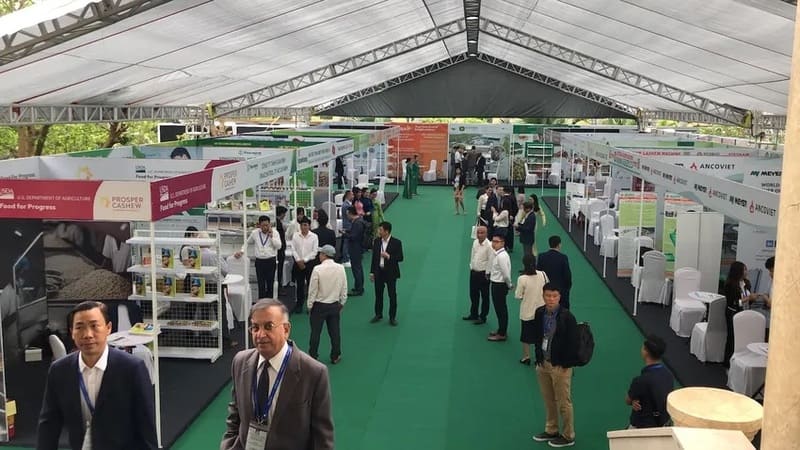
Another way is working with local agents and following updates from organizations such as VINACAS. You can also explore government-backed directories like VietnamExportData, which list licensed cashew exporters and offer shipment insights.
2. Online Portals
Finding Vietnamese suppliers online is the most convenient because everything is available online without travel. However, it is harder to verify supplier quality compared to the previous two. This is because you cannot directly inspect the factory, verify authenticity, or confirm operations from afar.
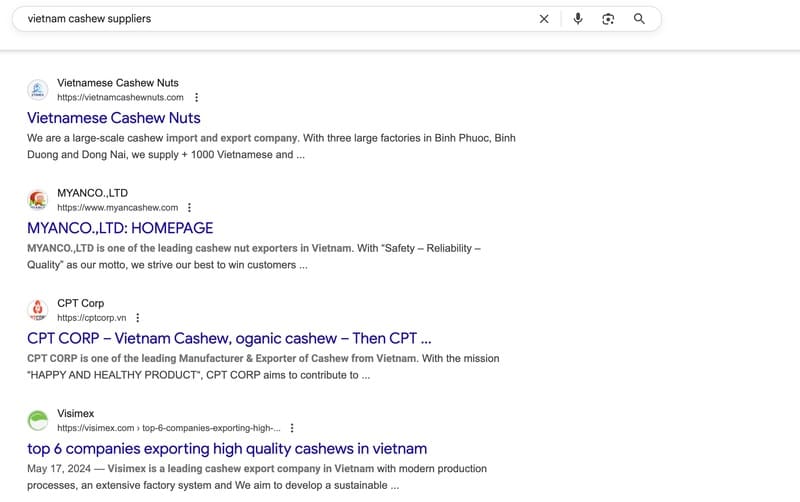
From our experience, it’s more reliable to find local cashew suppliers via verified B2B platforms like Alibaba, Global Sources, or VinaSources. Such platforms require suppliers to pass verification checks (on-site audits, business license proof, etc.) to be listed as “verified” suppliers. In other words, only companies that meet certain legal, financial, and operational standards can appear there.
On top of that, you can always contact the top established Vietnamese cashew suppliers. Below are some leading companies:
- Visimex Corporation JSC: One of Vietnam’s top cashew exporters, with over USD 430 million in exports in 2024, offering organic and premium kernels.
- Hoang Son I Joint Stock Company: Integrated cashew processor from Bình Phước, exporting to more than 50 countries with AFI certification.
- CPT Corporation: Recognized exporter supplying high-quality and organic cashew kernels, ranked among Vietnam’s top 10 exporters.
- Phuc An Cashew JSC: Mid-to-large exporter focusing on processed cashew kernels, listed in Vietnam’s top 10 exporters.
- Lafooco (Long An Food Processing Company): Long-standing brand in Vietnam with diverse cashew products and international market presence.
One small note is that these are big names in the industry. And working with them comes with stronger brand reputation, certifications, and higher compliance expenses. As a result, their products are usually priced higher than smaller or less established suppliers.
How To Import Cashews From Vietnam to the US
Importing cashew from Vietnam into the United States is not only about choosing a supplier, it requires you to follow a full process that covers everything from verifying licensed exporters, checking product grades and certifications, preparing the right FDA and USDA documents, ensuring packaging and labeling compliance, arranging international shipping, and finally handling customs clearance and duties in the US.
In the following, we will walk through 8 essential steps that guide you from the supplier side in Vietnam all the way to smooth entry at US ports.
1. Verify Licensed Cashew Exporters in Vietnam
Because cashew is an agricultural product, you as the importer must only work with exporters that can prove they are legally registered and compliant with food safety and grading standards. If you skip this step, US customs (FDA or USDA/APHIS) can hold or reject your shipment.
To verify a cashew supplier, you must:
- Check business registration: Ask for the exporter’s enterprise registration certificate (ERC). You can verify their enterprise code on the Vietnam National Business Registration Portal.
- Confirm export eligibility: Vietnamese cashew does not require a special export license, but the company must be registered with the Import-Export Department of the Ministry of Industry & Trade.
- Phytosanitary certificate: Every shipment must have a phytosanitary certificate issued by Vietnam’s Plant Protection Department. Without this, the shipment cannot clear US customs.
- Food safety certifications: Only buy from suppliers that hold HACCP, ISO 22000, or FSSC 22000, which are recognized by FDA for food imports.
- FDA Food Facility Registration: Only valid FDA-registered facilities can supply cashews to the US. You can cross-check it through the FDA Unified Registration and Listing Systems (FURLS) or with your U.S. customs broker who can confirm validity in the FDA database.
You can also use shipment databases like ImportYeti or ImportInfo to see if the supplier has exported to the US before. If not, you should be cautious and start with small trial shipments combined with third-party inspections.
2. Negotiate MOQ, Grades, Pricing and Contract
Now that you have probably picked out a supplier. The next step is to work with them. This involves discussing minimum order quantities (MOQs), negotiating the grade of cashew kernels, and agreeing on pricing and terms.
2.1. Cashew MOQs, Grades, Lead Time and Pricing
For minimum order quantities and lead time, MOQ varies depending on supplier size, processing capacity, and product grade. In general, Vietnamese cashew suppliers require MOQs in the range of 1 metric ton for kernels. Lead time is usually 7-14 days for kernel processing and shipment preparation. Some suppliers may quote 15-20 working days for full containers.
For your information, cashew grade means the kernel size, count per weight, broken percentage, color, and quality standard. These grading standards are international metrics, set by the Association of Food Industries (AFI) and widely used in global cashew trade . And they affect not only MOQ but also prices.

The most common grades in Vietnamese cashews are W320, W240, W180 for whole whites, and LWP (Large White Pieces), SWP (Small White Pieces), SP (Splits) for broken kernels. Grade W180 and W240 are premium whole kernel grades and are often produced from Binh Phuoc province. The other grades (like W320, LWP, SWP, SP) are less premium, with smaller size, more breakage, or lower visual quality.
Refer to the table below as a reference. The quoted price is FOB (meaning free on board, which is cost up to loading on ship, excluding ocean freight) from Ho Chi Minh City port.
| Type / Grade | Typical MOQ | FOB Price (USD/kg) | Typical Lead Time |
| W180 (Whole White) | 1 metric ton | ~ 8.1 – 8.3 USD/kg | 7-14 days |
| W240 (Whole White) | 1 metric ton | ~ 7.6 – 7.9 USD/kg | 7-14 days |
| W320 (Whole White) | 1 metric ton | ~ 7.2 – 7.5 USD/kg | 7-14 days |
| LWP (Large White Pieces) | 1 metric ton | ~ 5.5 – 5.8 USD/kg | 7-14 days |
| SP (Splits) | 1 metric ton | ~ 2.95 – 3.25 USD/kg | 7-14 days |
Most cashew suppliers from Vietnam are comfortable with ±5–10% on price or volume depending on season and supplier capacity. Feel free to ask them for a discount.
2.2. Terms and Contract Negotiation
It’s best to review key terms such as payment method and Incoterms. From our experience, you should use the irrevocable Letter of Credit (LC) or Telegraphic Transfer (TT) with deposit and balance against shipping documents. Incoterms for cashew exports from Vietnam are most commonly FOB Ho Chi Minh City or CIF major US ports.
Quality is also something to monitor closely. With Vietnam’s tropical climate and long harvest season, grades are generally consistent, but moisture content can cause mold during humid months.
You should also look carefully into lead time because Vietnamese holidays like Tết (Lunar New Year) can delay shipments by 1-2 weeks. Packaging and labeling requirements should be clearly specified. Do insist on clear written contracts and request bilingual versions (English-Vietnamese) to avoid misinterpretation.
3. Classify Cashews Under Correct HS Codes
After reaching an agreement on commercial terms, you should classify the cashew products under the correct HS code. In case you didn’t know, HS Code is the Harmonized System code used internationally to identify traded goods, and it will determine duties, tariffs, and the way your documents are filed.
In the US, classification uses the HTS (Harmonized Tariff Schedule) code. It expands the 6-digit HS code to 8-10 digits for more specific product detail. With agricultural products like cashews, HTS codes are assigned based on whether the cashew is in shell, shelled, raw, or otherwise prepared (e.g. roasted, salted) rather than by grade or whole/broken classification.
| Product Form | HTS Code | US Duty Rate (MFN) | VAT (US) |
| Cashew nuts, in shell | 0801.31.00 | Free (0%) | N/A |
| Cashew nuts, shelled (kernels) | 0801.32.00 | Free (0%) | N/A |
| Cashew nuts, prepared or preserved (e.g. roasted, salted) | 2008.19.15 | 2.8% ad valorem | N/A |
To determine whether your cashew shipment should be classified as in-shell, shelled kernels, or prepared/preserved, you should check the physical form of the product. Whole shelled kernels and broken cashew kernels often come in the whole cashew kernels. Roasted and seasoned cashews, on the other hand, are treated as prepared or preserved products. In-shell classification is rarely seen in Vietnamese cashews.
4. Register Your Facility with FDA
Food and Drug Administration (FDA) is a federal agency in the United States whose role is to protect public health by ensuring the safety of food imports. According to the FDA Food Facility Registration Rule, any shipment of cashews entering the US must be tied to an FDA-registered facility and importer. In other words, both the Vietnamese exporter’s facility and the US importer have to register with the FDA before shipments can be cleared.
To register, you go to the FDA Industry Systems portal and select the Food Facility Registration Module (FFRM) to register the foreign facility. Then fill in the facility name, address, contact person, US agent, types of activity (manufacture, pack, hold), and product categories.
Once finished, you will receive an FDA registration number. It’s worth noting that this number must be renewed every two years.
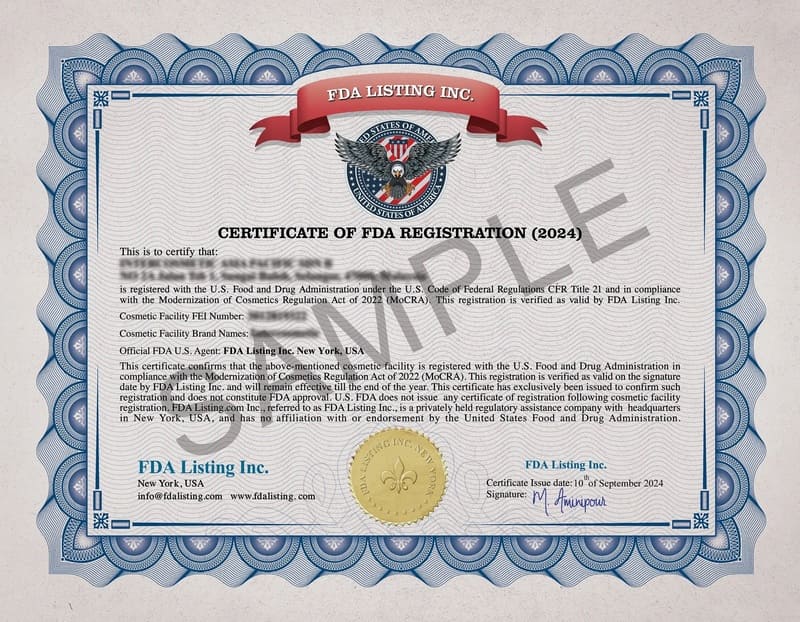
5. Submit Prior Notice For Each Cashew Shipment
Prior Notice is an electronic notification to FDA in advance of each food shipment to the U.S. The purpose is to allow the agency to review the shipment for safety risks, prevent unsafe food from entering, and verify that the producing facility has a valid FDA registration. Only one party (importer, exporter, broker, or U.S. agent) needs to submit the filing.
Prior Notice can be submitted via FDA’s PNSI portal or through CBP’s ABI/ACS system, and the deadline is no more than 15 days before arrival via PNSI and no more than 30 days via ABI/ACS. In the filling, you must declare shipment details such as:
- Product name: e.g. cashew kernels (raw, shelled)
- Manufacturer: facility in Vietnam that processed the cashews
- Shipper: exporting company in Vietnam
- Importer: U.S. importer of record
- Carrier: shipping line or airline transporting the goods
- Country of origin: Vietnam
- HTS code: classification of cashews under the US tariff schedule
When FDA confirms, you will receive a Prior Notice Confirmation Number. Without this confirmation, the shipment may be refused admission at the U.S. port.
6. Gather Essential Documentation For Vietnamese Cashew Import to US
How to import cashews from Vietnam into the US? Now that you have classified the HS code and completed FDA registration, you can move on to gathering the required documents.
For successful clearance, you need to prepare paperwork not only by requesting export documents from the Vietnamese supplier but also by arranging your own filings as the importer. That includes phytosanitary certificates and FDA food safety documentation.
6.1. Documents to Gather From Vietnamese Cashew Suppliers
- Commercial Invoice: Must clearly state exporter details, product description, HS code (0801.32 for cashew kernels), quantity, and price.
- Packing List: Shows net/gross weight, packaging type (vacuum, carton), and lot numbers. The weight must be stated in both kilograms (metric) and pounds (imperial), since US customs requires imperial units for clearance.
- Phytosanitary Certificate: Issued by the Vietnam Plant Protection Department confirming the shipment is pest-free (USDA APHIS).
- Certificate of Origin (Form B or RCEP if applicable): Issued by Vietnam Chamber of Commerce and Industry (VCCI) or Vietnam’s Ministry of Industry and Trade (MOIT), used for tariff benefits.
- Bill of Lading (B/L): Original or telex release, required for port clearance in the US.
- Food Safety/Quality Certificates: HACCP, ISO 22000, FSSC, or BRC copies to show FDA compliance.
- Certificate of Analysis (COA): Lab test results proving aflatoxin levels are below 20 ppb, plus moisture and microbiological safety. Acceptable COA must be from internationally-recognized labs for food safety testing, such as SGS, Bureau Veritas, or Eurofins.
6.2. Documents to Prepare as An Cashew Importer
- FDA Prior Notice: Mandatory filing before shipment arrives in the US.
- US Customs Entry Filing (CBP Form 3461/7501): Submitted via customs broker.
- Importer Security Filing (ISF “10+2”): Required for ocean shipments to the US, filed 24 hours before vessel loading.
- Customs Bond: Continuous or single entry bond filed with US CBP.
- Insurance Documents: If CIF, ensure policy covers full cargo value.
- Tax ID / DUNS / FSVP Agent Info: For FDA Food Safety Verification Program compliance (FDA FSVP).
Tips: Always request scanned copies in advance and originals for B/L, Phytosanitary, and CO. For certifications, notarized copies are usually sufficient.
7. Comply with FDA Labeling and Packaging Rules
On top of that, you must also ensure that the product meets US labeling and packaging rules. The US is very strict with agricultural imports, especially nuts like cashews, and both the label and the packaging must comply before the shipment can clear customs.
For Vietnamese cashew imports to the US, labels and packaging must include:
- Product name. For example, “Cashew Kernels” with the proper grade (e.g., W320, W240).
- Net weight:Stated in both pounds (imperial) and kilograms (metric) as required by US law.
- Country of origin: “Product of Vietnam.”
- Importer/distributor details: US importer’s name, address, and contact information.
- Allergen statement: Cashew is a tree nut and must be clearly declared on the label.
- Lot number or batch code: For traceability in case of recalls. This is a unique code given by the exporter during packing, printed on cartons or packs and sometimes listed in the packing list or COA for traceability.
- Packaging standards: Cashews must be vacuum-sealed or packed in moisture-proof, food-grade cartons/bags to prevent mold growth during long transit in tropical conditions.
- Ingredients list: Required if the cashews are processed. For example, roasted salted cashews sourced from Vietnam must have “Ingredients: Cashew Kernels, Salt”.
- Language: All mandatory information must be in English, though bilingual labels (English-Vietnamese) are acceptable if English is prominent.
8. Book Shipping and Custom Clearance
Shipping depends on the contract terms (Incoterms). Under FOB Vietnam, the importer books freight and insurance, while under CIF the exporter arranges it by contracting a forwarder, booking vessel space, and providing the Bill of Lading once goods are loaded.
When the shipment arrives at US entry ports, you will be responsible for filing entry with US Customs and Border Protection (CBP), submitting FDA Prior Notice confirmation, and presenting all documents (invoice, packing list, Certificate of Origin, phytosanitary certificate, Certificate of Analysis, Bill of Lading) for clearance.
Notes: CBP and FDA may hold shipments for inspection or sampling, including aflatoxin tests, before releasing the cargo. This is usually sample-based random testing, so importers should expect occasional delays until results are cleared.
Sourcing Vietnamese Cashews With VinaSources
So there you have it, the 8-step guide on how to import cashews from Vietnam to the USA. That sounds like a lot, right? But don’t worry; you will get used to the process quickly once you handle your first shipment. The bottom line is to keep paperwork transparent on both sides.
And if you are still unsure where to start, you can rely on VinaSources. As a leading B2B platform in Vietnam, we connect international buyers with verified cashew suppliers. You can browse listings, request quotes, and we will match your needs with the right exporter. For the export stage, VinaSources ensures all documentation and shipping papers comply with Vietnam’s standards and US import rules.
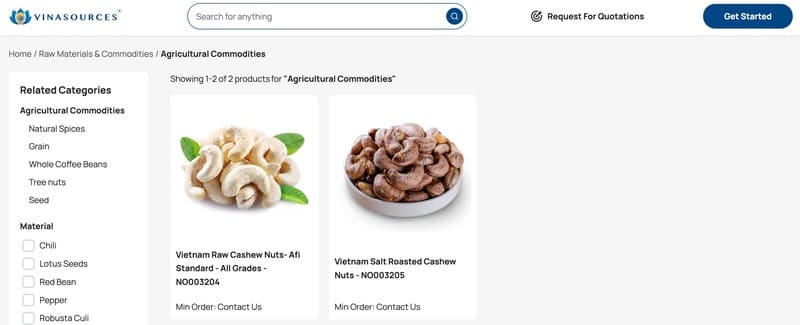
Currently, VinaSources lists two main cashew product categories: Vietnam raw cashew nuts and salt roasted cashew nuts. Don’t hesitate to send a Request for Quotation (RFQ)!
